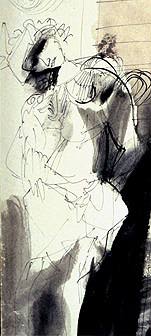|
|
1934, The Biographical Background |
|
 If you've found this site useful, we'd really appreciate a small donation to help with the hosting costs. Thanks! |
Allied to Picasso's fascination for Balzac's Unknown Masterpiece was his intention to create a single work which expressed all his important themes. Works which contained a convergence of themes usually only occurred at times of crisis and it is no coincidence that such works are now almost always regarded as important masterpieces. Picasso created his best work under stress.
Picasso was driven in his art by the need to unload himself of psychological concerns. The sequence of works leading up to the 1934 drawing and following on from it show that his principle worry at this time was the love triangle between himself, his wife Olga and his mistress Marie-Thérèse Walter.
In the early months of 1934 Picasso invented horrific bullfight scenes analogous to these developments.
The divorce unsettled Picasso enormously, affecting his peace of mind and threatening his family life and property. Another dimension to this crisis is that Marie-Thérèse may have undergone an abortion prior to or at the time of the drawing.
Symbols relating to a tragic pregnancy are repeated throughout the drawing and also appear in other works going back as far as 1925.
These terrifying visions of destruction and the artist's inevitable feelings of crucifixion are key elements in the drawing. Its unparalleled convergence of themes describe a tragic and terrifying theatre of the mind in which Picasso represents the two women in his life at this time as the two thieves at his own crucifixion. In addition to the torments of his personal life, in 1934 Picasso was greatly concerned about political developments in Europe. Another war with Germany seemed inevitable and as a result of this horrific realisation, powerful apocalyptic images which seem to have come from depths of hell itself, emerge, as if by magic, from mirror images of each side of the 1934 drawing. Further Reading: Herbert.T.Schwartz, Picasso and Marie-Thérèse 1925-27. Editions Isabeau, Canada, 1988.
© Mark Harris 1996 Overview
Next Section: Related Picassos |
|
|
|
     |
     |
|
|
© Mark Harris 1996 (content), Simon Banton 1996 (design) In general copyright of works by Pablo Picasso are the property of the heirs to the Pablo Picasso estate |
|

 Although the year 1934 is barely documented in Picasso biographies, it was without doubt one of the most critical years for Picasso, for it was the start of the worst period of his life.
Although the year 1934 is barely documented in Picasso biographies, it was without doubt one of the most critical years for Picasso, for it was the start of the worst period of his life.  Later the same year, Picasso's wife who has sometimes been described as a person possessed, appears to have discovered her husband's affair and not long after filed for divorce.
Later the same year, Picasso's wife who has sometimes been described as a person possessed, appears to have discovered her husband's affair and not long after filed for divorce. By July 1934, Picasso depicts his wife, who may have known about such a pregnancy, as a raging monster wielding a carving knife in a murderous attack on Marie-Thérèse.
By July 1934, Picasso depicts his wife, who may have known about such a pregnancy, as a raging monster wielding a carving knife in a murderous attack on Marie-Thérèse.